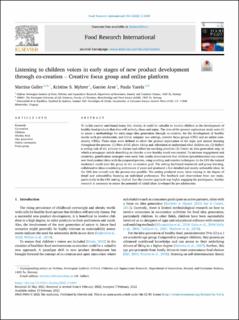| dc.contributor.author | Galler, Martina | |
| dc.contributor.author | Myhrer, Kristine S. | |
| dc.contributor.author | Ares, Gastón | |
| dc.contributor.author | Varela, Paula | |
| dc.date.accessioned | 2022-11-28T10:02:00Z | |
| dc.date.available | 2022-11-28T10:02:00Z | |
| dc.date.created | 2022-05-23T14:07:37Z | |
| dc.date.issued | 2022 | |
| dc.identifier.citation | Food Research International. 2022, 154 . | |
| dc.identifier.issn | 0963-9969 | |
| dc.identifier.uri | https://hdl.handle.net/11250/3034400 | |
| dc.description.abstract | To tackle current nutritional issues like obesity, it could be valuable to involve children in the development of healthy food products that they will actively chose and enjoy. The aims of the present exploratory study were (i) to assess a methodology for early-stage idea generation through co-creation, for the development of healthy snacks with pre-adolescents, and (ii) to compare two settings, creative focus groups (CFG) and an online community (ONL). Three steps were defined to allow the gradual exploration of the topic and mutual learning throughout the process: (1) Show &Tell: photo taking and -elicitation to understand what children ate; (2) Reflect: a sorting task of the pictures to discuss and reflect on snacking practices (3) Create: an idea generation step, in which a newspaper article describing an idea for a new healthy snack was created. To increase engagement and creativity, gamification strategies were used. Our results demonstrated that children (preadolescents) can create new food product ideas with the proposed process, using enabling and creative techniques. In the CFG the trained moderator could steer the group to the co-creation goal. The setting facilitated teamwork and group learning, collaborative ideas considering preferences of peers and produced a few detailed and mostly actionable ideas. In the ONL less control over the process was possible. The setting produced many ideas varying in the degree of detail and actionability focusing on individual preferences. The feedback and observations from our study, particularly in the CFG setting, implied that the creative approach was highly engaging for participants. Further research is necessary to assess the potential of initial ideas developed by pre-adolescents. | |
| dc.language.iso | eng | |
| dc.subject | Online community | |
| dc.subject | Online community | |
| dc.subject | Idea generation | |
| dc.subject | Idea generation | |
| dc.subject | Barn | |
| dc.subject | Children | |
| dc.subject | Co creation | |
| dc.subject | Co creation | |
| dc.subject | Healthy food | |
| dc.subject | Healthy food | |
| dc.title | Listening to children voices in early stages of new product development through co-creation – Creative focus group and online platform | |
| dc.title.alternative | Listening to children voices in early stages of new product development through co-creation – Creative focus group and online platform | |
| dc.type | Peer reviewed | |
| dc.type | Journal article | |
| dc.description.version | publishedVersion | |
| dc.source.pagenumber | 0 | |
| dc.source.volume | 154 | |
| dc.source.journal | Food Research International | |
| dc.identifier.doi | 10.1016/j.foodres.2022.111000 | |
| dc.identifier.cristin | 2026588 | |
| dc.relation.project | Norges forskningsråd: 314318 | |
| dc.relation.project | EC/H2020/764985 | |
| dc.relation.project | Nofima AS: 202103 | |
| cristin.ispublished | true | |
| cristin.fulltext | original | |
| cristin.qualitycode | 1 | |
